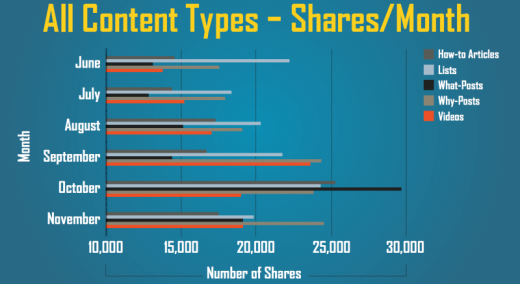
This post first appeared on Buffer.
So much of digital marketing these days is about producing high-quality content that gets published and shared.
You can control the publishing part. Can you control the sharing part?
Sharing begins with promotion—the timing, targeting, and strategy behind solid distribution.
To achieve your social media benchmarks, you need to understand what type of content will resonate in specific verticals, and when.
Fractl recently partnered with BuzzStream to analyze 220,000 articles from 11 verticals over six months – June to November 2014 – to determine how and when to publish content in order to score big on social media.
We’re excited to share with you what we found and to hear your thoughts!
Infographic: How and When to Publish Content in Order to Score Big on Social Media
We took the guesswork out of six months of content planning and created this social content calendar, which can help strategists determine the optimal month, vertical, and format for all of their content in 2015.
Study by Fractl and BuzzStream.
The 5 Types of Content (and Which Gets Shared Most)
First and foremost, know which content type performs best with your audience.
A successful campaign begins with great content, and the best content offers something new and valuable to your target audience while making an emotional connection. There are multiple ways to produce informative and engaging content, but if you want high social shares, your final asset depends on your promotion cycle’s month and vertical.
A successful campaign begins with great content, and the best content offers something new and valuable to your target audience while making an emotional connection. There are multiple ways to produce informative and engaging content, but if you want high social shares, your final asset depends on your promotion cycle’s month and vertical.
We divided the content of articles into five types: how-tos, lists, what-posts, why-posts, and videos:
- How-to posts introduce a problem, offer a solution, and then discuss each step to reach an end result.
Ex., How to Create Shareworthy Twitter Images: 10 Ways to Maximize Engagement on Your Tweets - Lists focus on a particular topic, offer a number of points about the topic, and provide a brief conclusion.
Ex., 15 Great Landing Page Design Examples You Need to See - What-posts provide further information on a specific topic, with many articles making comparisons of one thing to another.
Ex., What SEO Used to Be Versus What SEO Is Now - Why-posts typically provide readers with a reason or purpose and provide details that support a focused conclusion.
Ex., Why Introverts Now Rule the World - Videos provide the audience with a dynamic visual of the topic discussed within the article.
Ex., A Look at the Economy of the Future
The most consistently shared formats were lists and why-posts, varying less than 2.5 percent and averaging around 21,000 shares per month.
What-posts were the riskiest format, with a high variance at 13.45 percent, performing lowest in July with fewer than 15,000 shares, yet outperforming every other vertical in October with nearly 30,000 shares.
Further analysis of the six-month period revealed:
- October was the most popular month for shares: all but one content type (videos) exceeded 20,000 shares.
- Lists narrowly claimed the most social traction at 22.45 percent with why-posts in a close second at 22.32 percent.
- Videos drew 18.94 percent of total shares and performed well in Q4.
- How-to articles earned 18.42 percent and saw extra shares in August and November.
- What-posts had the lowest social traction, earning 17.88 percent of total shares, but got the most shares out of every content type in October.
The content type also influenced social metrics depending on which vertical published the asset, proving that each audience has its own preference.
For example, lists earned 40 percent of total shares in the automotive vertical but only managed 10 percent in education. How-to posts did the best in the food vertical at 37 percent. And although they earned around 30 percent of shares in both the education and entertainment verticals, videos were one of the lowest-performing content types overall, coming in last in multiple verticals.
How Social Shares Vary by Month
- News was the only vertical to see three content types reach more than 5,000 shares in June.
- None of the five content types reached 6,000 shares in any vertical during July and August.
- All content types exceeded 4,000 shares in October although not within the same vertical.
- Only two content types – videos and what-posts – exceeded 6,000 shares in September.
A great example of a high-performing article in June is this feature on Twitter reading levels by state. Lists was one of only two content types that exceeded 7,500 shares during the month, and the campaign capitalized on this trend by including an interactive map that lists each state’s average IQ. The result? The article earned over 9,000 shares.
The Most Popular Industries for Social Shares
Next, get to know your verticals and their target audience.
An effective social content calendar looks at all channels for promotions in order to determine what is popular and timely for your target audience. Within each of the 11 verticals – automotive, education, health, finance, food, business, technology, travel, entertainment, news, and lifestyle – we identified the top 20 websites.
Filtering these results by content type and date, we saw that although the average number of social shares per vertical did not vary wildly – usually less than 10 percent each month – some verticals outperformed others.
For example, the news vertical saw the highest social traction, averaging more than 28,000 shares each month. Its high performance is likely due to it being the most all-encompassing vertical.
The second highest-performing vertical, entertainment, averaged more than 17,000 shares a month, while travel rounded out the top three with an average of more than 10,000 shares.
A breakdown of the other verticals revealed:
- Lifestyle, tech, finance, business, and education averaged between 5,000 and 9,000 shares, nearly three times less than the news vertical.
- Business was the only vertical to have a single-digit variance for all content types, emphasizing that its readers have a consistent sharing habit.
- Automotive, health, and food averaged between 2,000 and 5,000 shares, food being the lowest-performing vertical with fewer than 2,500 social shares a month.
- News was the only vertical that saw specific content types pass 5,000 shares.
A high-performing article that reaffirms the entertainment vertical’s high social traction is this feature on superhero style. Videos within the vertical were some of the highest-performing content type during the entire month of August, and this post earned over 5,000 views.
Content type vs. vertical
The type of content that performed well per vertical also reflected audience behaviors within the specific niche.
For example, lists proved the best content type for the travel vertical, claiming 32 percent of shares. The list format corresponded with what people do when planning for a trip: Write down where they want to go, what they need to pack, and other details.
Similar findings include:
- Social shares within the technology vertical increased during the end of the year, possibly corresponding with when its audience searched online for the latest gadgets to complete their holiday shopping.
- July was the lowest-performing month for the education vertical, claiming only 10.57 percent of total shares; this coincides with school being closed for the summer.
- How-to articles were the most consistent performers within the automotive audience, corresponding with the highly practical and technical nature of the subject matter.
Final takeaways
With more than 128,000 shares, October emerged as the month with the highest social traction, while June and August seemed to have the lowest shares for most verticals.
But that doesn’t mean you should save your promotional efforts for the fall. A closer look at the data determined:
- Automotive earned most of its shares in July, specifically with what-posts exceeding 3,000 social shares.
- Social traction in the business vertical remained consistent for five months, between 8,000 and 9,000 shares, before dropping in November.
- Lifestyle and finance both saw their highest monthly shares in September, with what-posts performing the highest in lifestyle and lists providing the highest social traction in finance.
- Videos did best in September with more than 24,000 shares.
Great content is at the heart of successful content marketing strategy, but one of the biggest takeaways from our research is timing.
A month early or a month late can make your campaign less relevant and affect its overall social traction.
Using our social content calendar as a reference, you can create a promotions strategy that will deliver timely content to a highly-engaged target audience, especially if you want your content to “go viral.” Understanding what type of content will resonate with your audience and when to publish it will help you hit high social metrics, and continually monitoring these metrics is the best way for content marketers to create a successful outreach strategy.
Over to you
What stood out to you from this research?
Might the findings impact the type of content you create and when you schedule it?
Read Next: 61 key social media metrics, defined
Get the TNW newsletter
Get the most important tech news in your inbox each week.









